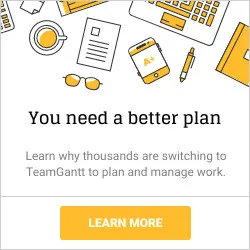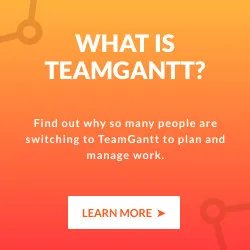6 Questions to Answer Before Starting Your Project Plan
.webp)
.webp)



The following post is an excerpt from our "Guide to Project Planning." Download it now for more info on how to build a great project plan.
So you’ve asked enough questions and feel that you have acquired all of the possible information about the project that you’ll need to craft a plan, it’s time to get serious.
Chances are, you’re feeling fully prepared and ready to dig into the hows and whens of the project. It’s so easy to jump right into your project planning tool of choice to create what looks like a well-thought-out plan.
If that’s your process, that's fine! Just be sure to think through every possible scenario before you put the time and effort into a formalized document. If you don’t, you’ll have to go back through your work and make adjustments, and we all know that could end up taking more time than you bargained for.
So why not start with a simple sketch to map out and communicate your ideas on process, deliverables, dependencies, and timing? It can take you as little as 20 minutes and will help you sell your ideas to your team before delivering something that feels “written in stone.”
Grab a pen and a notebook, or stand in front of a whiteboard and sketch out your ideas.
Feeling overwhelmed, or don’t know where to start? Take a look at your scope document—does it outline specific deliverables or timing? Did you take a step back and review your team’s high-level project timeline to get a good understanding of all the moving pieces within this scope of work? Refer back to your meeting notes—when you asked your clients all of those questions, did any specific process tweaks come up? Are there dates or events you need to keep in mind?
If this is new to you, it can feel slightly lost. But it’s so important to remember that the tool you’ll put the plan in won’t do the thinking for you. You control the process, and you can craft a plan without any tool at all. Just keep these factors in mind.
1. What's the overall approach to the project?
What’s the first deliverable? What comes after that? How do those deliverables help you get to the end goal? Does your team prefer to work within the framework of a methodology like Agile? What are the frameworks that you can apply to this project given the variables you discovered in your pre-project client Q&A? Did you ask these 7 important questions before you began?
2. What tasks will need to be completed?
Don’t think about your project in phases. Think about deliverables. For instance, if you’re delivering a design concept, what work needs to be done before that can begin, and what work can happen when it’s approved—or concurrently? Knowing about each task, and planning their dependencies will help you to string everything together.
3. What roles or people will work on the project?
Who’s on your project team and what do they do? Also, how can you leverage their expertise and collaboration to get things done more efficiently?
If you have an idea of how your team could work together and present ideas to them, they’re going to be more open to discussing process and coming up with ideas on how to approach the project together. If you harness the power of team collaboration before your work starts, you’ll find that the work product will be stronger and the team will be happier.
You’ll also want to keep resourcing in mind. If your organization allows people to be on more than one project at a time, that can potentially cause conflicts on your project. That’s a headache you’ll want to avoid. Be sure to review resourcing plans and ensure that your team is available to conduct the work on your project over the course of time you’re estimating.
4. How much time do you and your team need to execute work?
Be honest about the time your team will need to get their work done. Don’t forget to look back at your project estimate (if you have one) to see how many hours were scoped for tasks. This can be a huge help in determining timelines. But, of course, there are other things to consider as well.
Having a hard time sorting out how long it will take you to get a task done?
Try a Work Breakdown Structure, a fixture in classic project management methodology and systems engineering that helps you to break a project task into smaller components. Creating a work breakdown structure for any plan or set of tasks helps you get granular about the work that needs to be done on any given project. Check out these Work Breakdown Structure examples.
Benefits of the WBS include:
- You get granular quickly and can create a simple time estimate
- You can confirm steps with your team in an easily digestible way
- You can use these steps as a To-Do list related to the task
- You can use these details to educate your client on the effort involved with any task
- You can identify where others might be able to step in and help based on the tasks that roll-up to the main task
Once you’ve created one WBS for a task, you will be able to use it on other projects and easily tweak it based on project variables.
5. What other project work will you have going at the same time?
If you’re working on a team of people who are working on multiple projects, you’re going to want to be sure you have a complete picture of each person’s availability. If they are responsible for other projects, you’ll want to discuss key dates to avoid so you don’t make the mistake of double-booking (and stressing out/upsetting) your team.
6. What important dates do you need to block out?
Your plan will crumble as soon as you hit a date that doesn’t work for your team or your clients. Check schedules on both sides of the fence and be sure to account for holidays, closings, vacations, meetings, and any other possible date that could cause outages. If you get ahead of that kind of information before you commit to a plan, you won’t have to freak out about delays and risks due to a missed meeting or deadline.
As soon as you’re comfortable with your plan, take some time to review it (and all of those assumptions) with your team. It can be a short, relaxed meeting to work out the overall process, deliverables, responsibilities, timing, and anything else under the sun that could impact the success of the project. As a team, you should be able to agree on what’s going to work, and when you have everyone’s buy-in on the overall approach, you’ll be one step closer to having a plan that not only looks great, it will feel appropriate and workable.
Build a clear and confident plan for free
Want to save time and effort on planning? TeamGantt makes it easy to create, track, and collaborate on all your project plans in minutes.
You’ll have all the features you need to ensure projects finish on time and under budget—from drag and drop simplicity and team collaboration to customizable views and workload management.
Best of all, it’s all wrapped up in a simple and intuitive interface your whole team will love. 😍